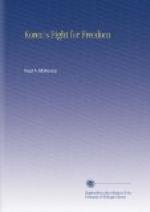But it soon became clear that there were men who had not taken the filching of their national independence lightly. Refugees from distant villages, creeping after nightfall over the city wall, brought with them marvellous tales of the happenings in the provinces. District after district, they said, had risen against the Japanese. A “Righteous Army” had been formed, and was accomplishing amazing things. Detachments of Japanese had been annihilated and others driven back. Sometimes the Japanese, it is true, were victorious, and then they took bitter vengeance, destroying a whole countryside and slaughtering the people in wholesale fashion. So the refugees said.
How far were these stories true? I am bound to say that I, for one, regarded them with much scepticism. Familiar as I was with the offences of individual Japanese in the country, it seemed impossible that outrages could be carried on systematically by the Japanese Army under the direction of its officers. I was with a Japanese army during the war against Russia, and had marked and admired the restraint and discipline of the men of all ranks there. They neither stole nor outraged. Still more recently I had noted the action of the Japanese soldiers when repressing the uprising in Seoul itself. Yet, whether the stories of the refugees were true or false, undeniably some interesting fighting was going on.
By the first week in September it was clear that the area of trouble covered the eastern provinces from near Fusan to the north of Seoul. The rebels were evidently mainly composed of discharged soldiers and of hunters from the hills. We heard in Seoul that trained officers of the old Korean Army were drilling and organizing them into volunteer companies. The Japanese were pouring fresh troops into these centres of trouble, but the rebels, by an elaborate system of mountain-top signalling, were avoiding the troops and making their attacks on undefended spots. Reports showed that they were badly armed and lacked ammunition, and there seemed to be no effective organization for sending them weapons from the outside.
The first rallying-place of the malcontent Koreans was in a mountain district from eighty to ninety miles east of Seoul. Here lived many famous Korean tiger-hunters. These banded themselves together under the title of Eui-pyung (the “Righteous Army"). They had conflicts with small parties of Japanese troops and secured some minor successes. When considerable Japanese reinforcements arrived they retired to some mountain passes further back.
The tiger-hunters, sons of the hills, iron-nerved, and operating in their own country, were naturally awkward antagonists even for the best regular troops. They were probably amongst the boldest sportsmen in the world, and they formed the most picturesque and, romantic section of the rebels. Their only weapon was an old-fashioned percussion gun, with long barrel and a brass trigger seven to eight inches in length. Many of them fired not from the shoulder, but from the hip. They never missed. They could only fire one charge in an attack, owing to the time required to load. They were trained to stalk the tiger, to come quite close to it, and then to kill it at one shot The man who failed once died; the tiger attended to that.




